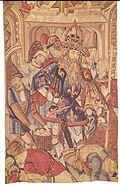
The Hestia tapestry is a Byzantine-era pagan tapestry made in the Diocese of Egypt in the first half of the 6th century. It is now in the Dumbarton Oaks Collection in Washington DC, but generally not on display.
The Hestia tapestry, which is made of wool, is a late representation of the goddess Hestia. It measures 114 x 136.5 cm (44.9 x 53.7 inches). It shows the goddess enthroned with two attendants and six putti. The tapestry is identified in Greek as “Hestía Polýolbos" or "Hestia full of Blessings" (Greek: Ἑστία Πολύολβος) and is depicted mainly through the use of pomegranate fruit. Her headdress and earrings are made from pomegranates while the blessings that Hestia gives out are in the form of the fruit.
The tapestry's history and symbolism are discussed in Friedlander (1945). Scholars note that this pagan artifact was often displayed in Christian households in Egypt.
Bibliography
- Kitzinger, Ernst. Handbook of the Byzantine Collection. Washington, D.C.: Dumbarton Oaks, 1967
- Friedlander, Paul. Documents of a Dying Paganism: Textiles of Late Antiquity in Washington, New York, and Leningrad. Berkeley, University of California Press, 1945
- Sessa, Kristina. Daily Life in Late Antiquity. Cambridge: Cambridge University Press, 2018
- Shrenk, Sabine. "The Background of the Enthroned: Spatial Analysis of the Hanging with Hestia Polyolbos in the Dumbarton Oaks Collection." In Catalogue of the Textile in the Dumbarton Oaks Byzantine Collection, eds. Gudrun Bühl and Elizabeth Dospěl Williams. Washington, D.C.: Dumbarton Oaks, 2019
- Stone, Damien. Pomegranate: A Global History. London: Reaktion Books, 2017
References
- "Hestia Polyolbos Tapestry". Feminae: Medieval Women and Gender Index.
- Shrenk, Sabine. "The Background of the Enthroned: Spatial Analysis of the Hanging with Hestia Polyolbos in the Dumbarton Oaks Collection". Dumbarton Oaks.
- ^ Oaks, Dumbarton; Kitzinger, Ernst (1967). Handbook of the Byzantine Collection. Washington, D.C.: Dumbarton Oaks. p. 108. ISBN 9780884020257.
- Stone, Damien (2017-05-15). Pomegranate: A Global History. Reaktion Books. ISBN 9781780237954.
- Friedlander, Paul. (1945). Documents of Dying Paganism. University of California Press.
- Sessa, Kristina (2018). Daily Life in Late Antiquity. New York: Cambridge University Press. p. 117. ISBN 9780521766104.
External links
This Byzantine Empire–related article is a stub. You can help Misplaced Pages by expanding it. |
This textile arts article is a stub. You can help Misplaced Pages by expanding it. |
